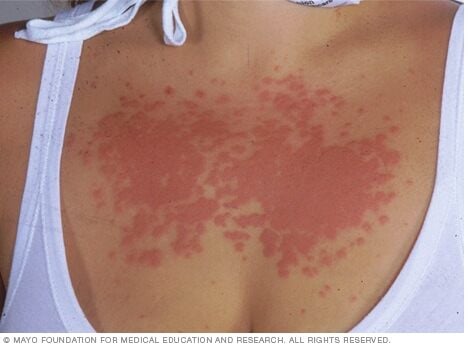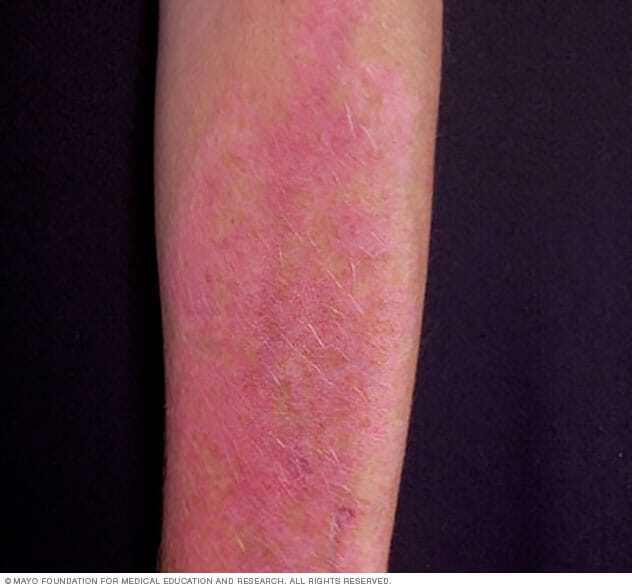Polymorphous light eruption
Overview

Polymorphous light eruption is a rash caused by sun exposure in people who have developed sensitivity to sunlight. The rash usually appears as tiny, inflamed bumps or slightly raised patches of skin.
The reaction usually happens during spring and early summer when exposure to sunlight increases. It's less likely to be repeated as the summer progresses. But the rash often happens again each year after the first time. If you're going to develop this sensitivity, the first instance will likely be in your teens or 20s.
The condition is also known as polymorphic light eruption, sun allergy and sun poisoning.
Polymorphous light eruption usually goes away on its own without scarring within 10 days. People with severe or persistent rashes may need medication.
Symptoms

Symptoms of the rash in polymorphous light eruption may include:
- Dense clusters of small bumps and blisters
- Inflamed, raised rough patches
- Itching or burning
People may rarely have other symptoms such as fever and chills.
In polymorphous light eruption, eruption refers to the rash, which usually appears 30 minutes to several hours after sun exposure. The rash usually appears on areas of the body that are covered during winter but exposed in summer such as the upper chest, front of the neck and arms.
When to see a health care provider
See your health care provider if you have any rash with no obvious cause, such as a known allergy or recent contact with poison ivy.
Polymorphous light eruption rashes look similar to rashes caused by other diseases, some of which are serious. So it's important to get a prompt diagnosis and treatment.
Seek immediate medical care if your rash is:
- Widespread
- Painful
- Accompanied by fever
Causes
The exact cause of polymorphous light eruption isn't understood. The rash appears in people who have developed sensitivity to sunlight, especially ultraviolet (UV) radiation from the sun or other sources, such as tanning beds. This is called photosensitivity. It leads to immune system activity that causes a rash.
UV radiation
UV radiation is a wavelength of sunlight in a range too short for the human eye to see. UV light that reaches the earth is divided into two wavelength bands — ultraviolet A (UVA) and ultraviolet B (UVB).
A person with photosensitivity can react to both types of UV radiation. UVB doesn't penetrate glass. UVA does. Exposure to sunlight through windows or even sunscreen-protected skin may cause a reaction in some people with photosensitivity.
Photosensitivity
With polymorphous light eruption, sensitivity to sunlight lessens with repeated exposure. Features of polymorphous light eruption are somewhat predictable:
- An episode is most likely to occur after the first one or two times of sun exposure after a long period of no exposure, such as in spring or early summer.
- Episodes are less likely to happen as the summer progresses.
- After the first episode, it's likely to happen each year. Some people gradually become less sensitive over several years and eventually no longer experience the yearly rash.
Risk factors
Anyone can develop polymorphous light eruption, but several factors are associated with an increased risk of the condition:
- Being female
- Having skin that sunburns easily
- Living in northern regions
- Having a family history of the condition
Diagnosis
Your health care provider can probably make a diagnosis of polymorphous light eruption based on a physical exam and your answers to questions. Your health care provider might have you undergo laboratory tests in order to confirm a diagnosis or rule out other conditions. Tests may include:
- Skin biopsy. Your health care provider removes a sample of rash tissue (biopsy) for testing in a lab.
- Blood tests. A member of your care team draws blood for testing in a lab.
- Phototesting. A specialist in skin conditions (dermatologist) exposes small areas of your skin to measured amounts of UVA and UVB light to try to reproduce the problem. If your skin reacts to UV radiation, you're considered sensitive to sunlight (photosensitive) and may have polymorphous light eruption or another light-induced disorder.
Other light-induced conditions
Your health care provider might need to rule out other disorders characterized by light-induced skin reactions. These conditions include:
- Chemical photosensitivity. A number of chemicals — drugs, medicated lotions, fragrances, plant products — can induce photosensitivity. When this occurs, the skin reacts each time it's exposed to sunlight after ingesting or coming into contact with a particular chemical.
- Solar urticaria. Solar urticaria is a sun-induced allergic reaction that produces hives — raised, inflamed, itchy welts that appear and disappear on the skin. The welts can appear within a few minutes of sun exposure and last for a few minutes to hours. Solar urticaria is a chronic condition that can last for years.
- Lupus rash. Lupus is an inflammatory disorder that affects a number of body systems. One symptom is the appearance of a bumpy rash on areas of skin exposed to sunlight, such as the face, neck or upper chest.
Treatment
Treatment of polymorphous light eruption usually isn't needed because the rash usually goes away on its own within 10 days. If your symptoms are severe, your health care provider may prescribe anti-itch medicine (a corticosteroid cream or pill).
Phototherapy
Your health care provider may suggest phototherapy to prevent seasonal episodes of polymorphous light eruption if you have disabling symptoms. This exposes the skin to small doses of UVA or UVB light that helps your skin be less sensitive to light. It mimics the increased exposure you would experience during a summer.
Self care
Self-care measures that may help ease signs and symptoms include:
- Applying anti-itch cream. Try a nonprescription anti-itch cream, which may include products containing at least 1% hydrocortisone.
- Taking antihistamines. If itching is a problem, oral antihistamines may help.
- Using cold compresses. Apply a towel dampened with cool tap water to the affected skin. Or take a cool bath.
- Leaving blisters alone. To speed healing and avoid infection, leave blisters intact. If needed, you can lightly cover blisters with gauze.
- Taking a pain reliever. A nonprescription pain medication may help reduce inflammation and pain.
- Protect the rash from further sun exposure. When you go outside, cover the area where the rash developed.
To lessen the likelihood of recurring episodes of polymorphous light eruption, take the following precautions:
- Avoid the sun between 10 a.m. and 2 p.m. Because the sun's rays are most intense during this time, try to schedule outdoor activities for other times of the day.
- Use sunscreen. Fifteen minutes before going outdoors, apply a broad-spectrum sunscreen, one that provides protection from both UVA and UVB light. Use a sunscreen with a sun protection factor (SPF) of at least 30. Apply sunscreen generously, and reapply every two hours — or more often if you're swimming or perspiring. If you're using a spray sunscreen, be sure to cover the entire area completely.
-
Cover up. For protection from the sun, wear tightly woven clothing that covers your arms and legs. Consider wearing a broad-brimmed hat, which provides more protection than does a cap or visor.
Consider wearing clothing designed to provide sun protection. Look for clothes labeled with an ultraviolet protection factor (UPF) of 40 to 50. Follow care instructions on the label of UV-blocking clothes to maintain their protective feature.
Preparing for your appointment
You're likely to start by seeing your primary care doctor. He or she may refer you to a specialist in skin diseases (dermatologist).
Here's some information to help you get ready for your appointment.
What you can do
- Be aware of any pre-appointment restrictions. At the time you make the appointment, be sure to ask if you need to do anything in advance.
- List any symptoms you're experiencing, including any that may seem unrelated to the reason for which you scheduled the appointment.
- List key personal information, including any major stresses or recent life changes.
- List all medications, vitamins or supplements that you're taking, including doses.
- List questions to ask your health care provider.
For polymorphous light eruption, some basic questions to ask your health care provider include:
- What's the most likely cause of my symptoms?
- What tests do I need? Do they require any special preparation?
- Is this condition temporary or long lasting?
- Is it possible this condition is related to a more serious illness?
- What treatments are available, and which do you recommend?
- What side effects can I expect from treatment?
- Do I need to follow any restrictions?
- Is there a generic alternative to the medicine you're prescribing me?
- Do you have any brochures or other printed material I can take with me? What websites do you recommend?
What to expect from your health care provider
Your health care provider will ask you a number of questions about your symptoms and your medical history, such as:
- When did the rash appear?
- Does it itch or cause pain?
- Have you had a fever associated with the rash?
- Do you have any other symptoms?
- Did you recently start a new medication?
- Have you recently used a cosmetic or fragrance in the area of the rash?
- Have you had a similar rash before? When?
- Has the duration of your sunlight exposure increased recently?
- Have you recently used a tanning bed or lamp?
- Do you use sunscreen?
What you can do in the meantime
Avoid sun exposure whenever possible. If you can't avoid the sun, use a broad-spectrum sunscreen with an SPF of at least 30 in areas that cannot be protected by clothing. Apply it generously 15 minutes before sun exposure. Reapply it every two hours or more often if you're swimming or sweating. This won't totally protect you from a reaction, as ultraviolet A may penetrate through most sunscreens.



